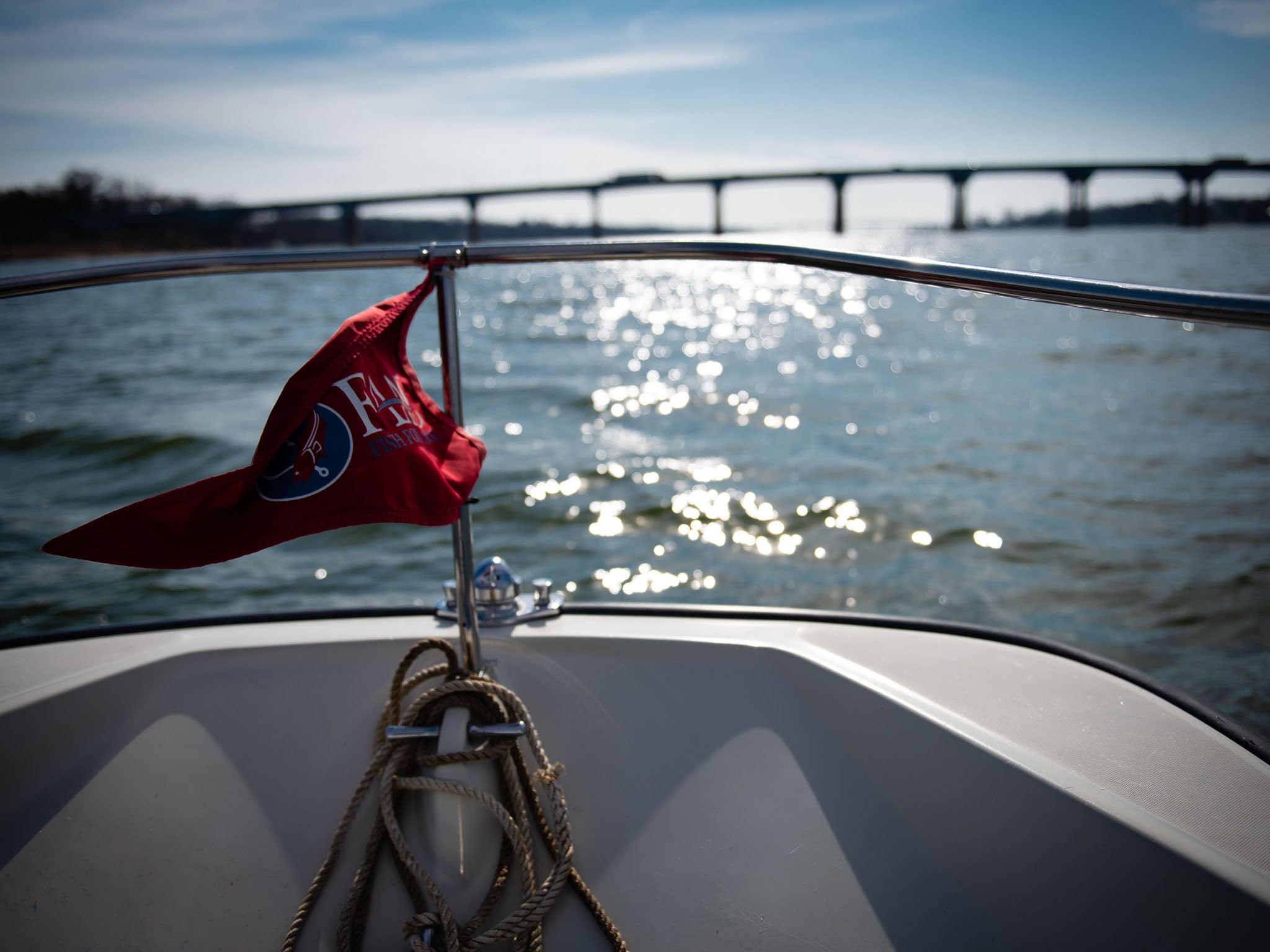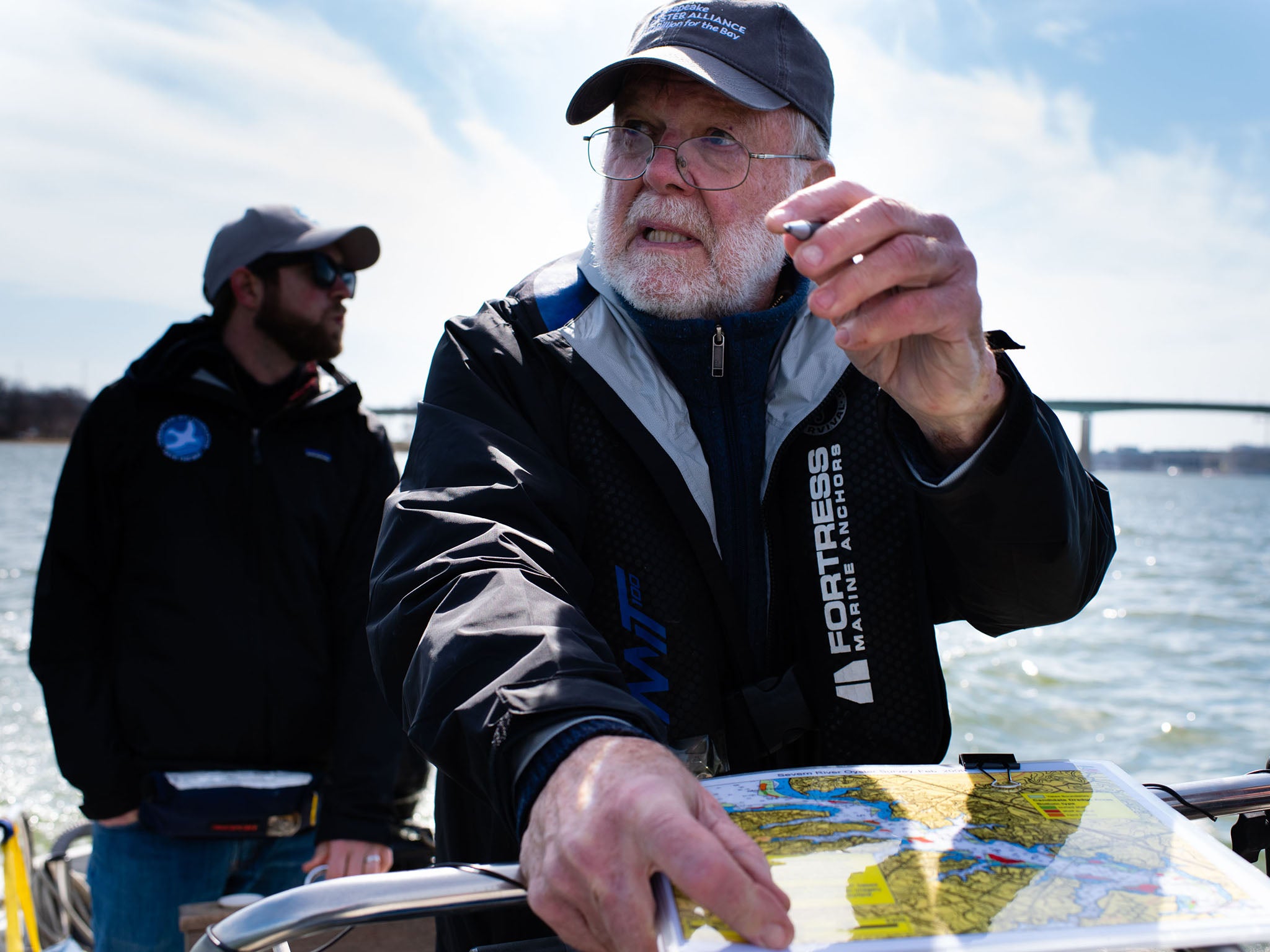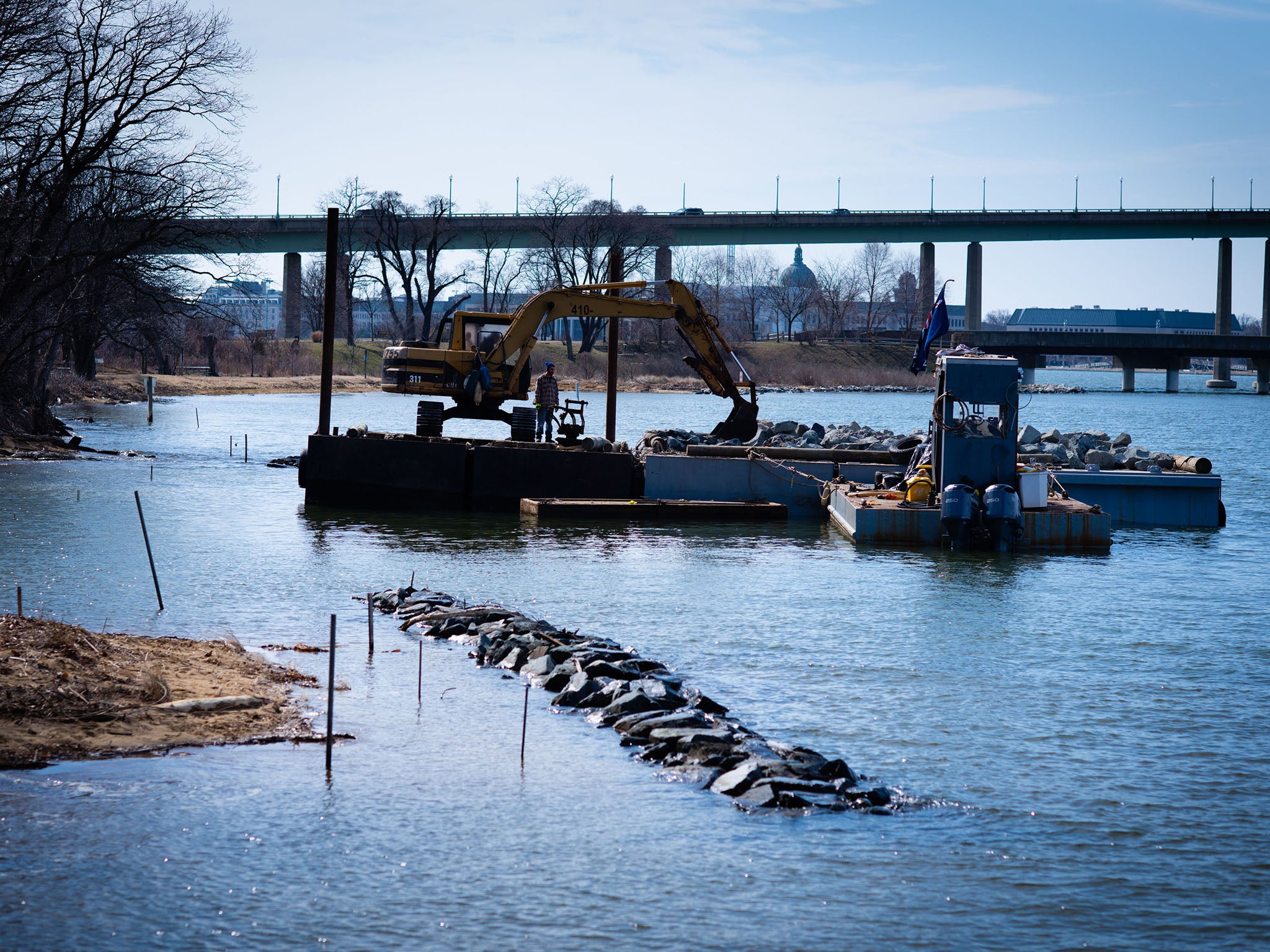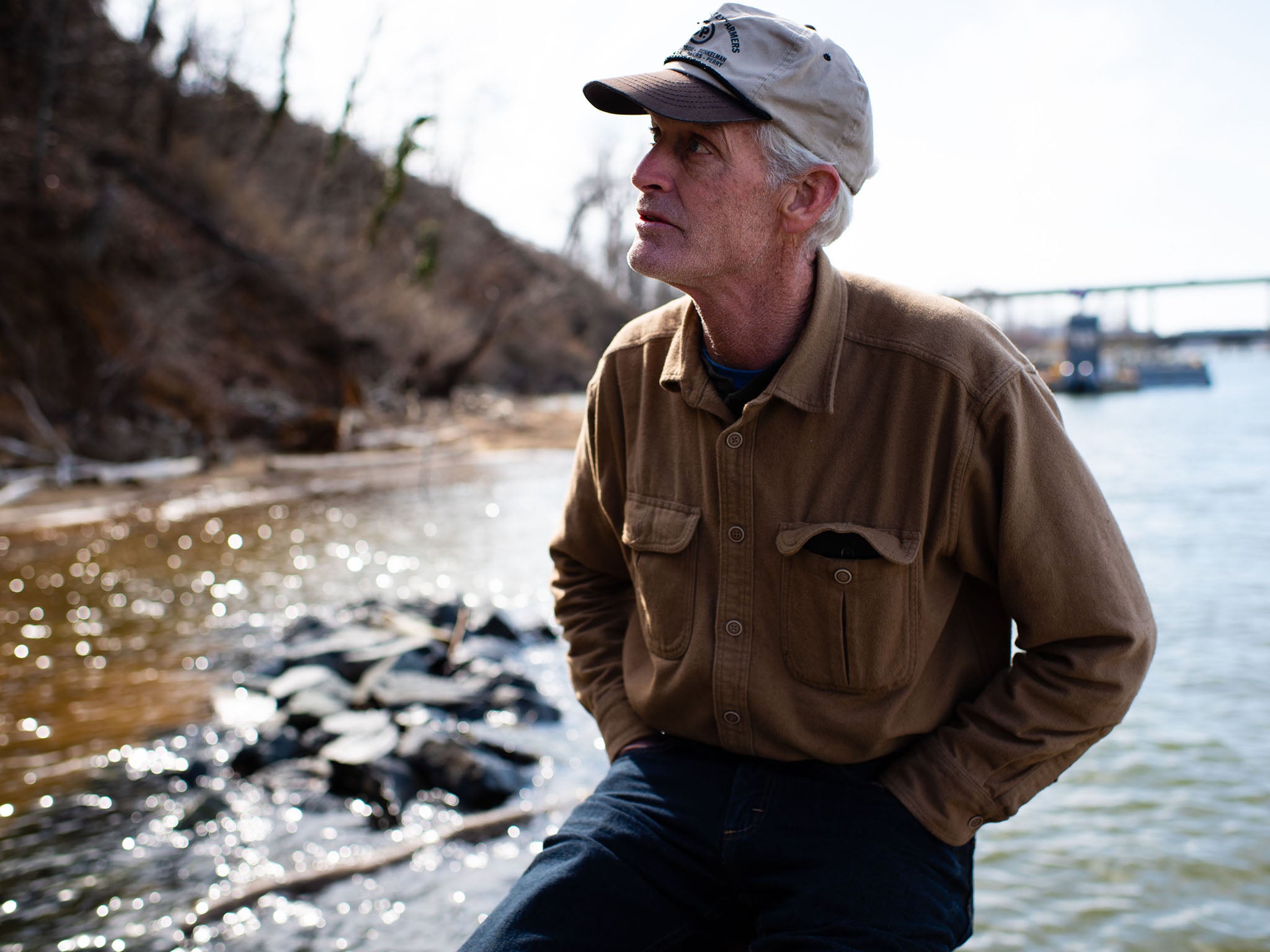Just as the Chesapeake Bay recovers, its funding is stripped away
The Chesapeake Bay ecosystem is the healthiest it has been in generations, writes Marissa J Lang. But extreme budget cuts threaten its stability

He knows where the seagrass likes to grow, where the ospreys return to roost and the oysters have begun to form reefs – like back in the good old days before everything, it seemed, began to wither and die.
John Page Williams, a naturalist with the nonprofit Chesapeake Bay Foundation in Annapolis, Maryland, doesn’t want to go back to those days. Those days when he could smell the rot of the river in the middle of winter, when chemical waste and oyster degradation ran unchecked, when the sturgeon disappeared and even the birds seemed to give up hope.
“I can take you out and show you stuff that will make you just grin from ear to ear, and stuff that will make you cry within 50 yards of each other,” says Williams, 76. “After seeing what I’ve seen on these rivers over the last 35 years, I’ll say this: I won’t bet against anything. I won’t bet against the Anacostia [River] being swimmable again within this century. But it’s a long grind. And you have to keep supporting the programmes and efforts that are actually helping to make that happen.”
Williams and others credit the ecosystem‘s steady and significant recovery to a complex web of federal, state and private restoration efforts coordinated by the Environmental Protection Agency’s Chesapeake Bay Programme, a partnership among six states and the district that has existed since 1983.
President Donald Trump earlier this month released a federal budget proposal that would cut EPA funding for the programme by 90 per cent.
It is the third time the president has proposed a dramatic slash in funding for the Chesapeake Bay as part of EPA budget cuts. Last year, he recommended a similar 90 per cent chop. In 2017, he suggested eliminating federal contributions to the Chesapeake restoration effort altogether.
In both cases, congress rejected the president’s proposals and restored funding to the programme. Lawmakers say they expect a similar repudiation this year. But Will Baker, director of the Annapolis-based Chesapeake Bay Foundation, says “spending political capital” to convince members of congress to fight for the programme’s survival has no guarantees.
The programme received $73m (£55m) in federal funding for this fiscal year. The Trump administration’s 2020 budget proposal would make that $7.3m.
A cut that drastic would have dire consequences for the bay and residents of the Washington area, Baker and Williams say.

“It wouldn’t happen fast, but once it started to degrade again, it would be bloody hell to turn back around,” Williams says.
Those who work along the Chesapeake Bay estuary like to compare its recovery to a sick patient in the early throes of remission. Would you stop the patient’s supply of lifesaving medicine, they ask? Eliminate doctors’ visits? Cut their health insurance?
“Of course not,” says John Flood, 63, a marine consultant and longtime environmental activist from Annapolis. “This patient is about to get up out of the hospital bed and get back to a functioning life again. This is the worst possible time to take funds away. It’s time for all hands on deck.”
Scientists say the Chesapeake Bay ecosystem is the healthiest it has been in generations.
Species thought to be long gone are making a come back. Signs of natural resiliency have returned. That means the nation’s largest estuary is better able to recover on its own from setbacks – like last year’s record-setting rainfall, which offset the natural salinity of many of the region’s waterways.
But experts worry the Chesapeake Bay might not be able to weather a drastic budget cut on its own.

“The recovery is fragile,” Baker says. “We certainly know that. We saw the impact of record-breaking rainfall last year. When a system is in recovery and the recovery is fragile, the worst thing to do is pull the rug out from under the very programmes that are improving it and making it stronger.”
More than two-thirds of the $73m the programme receives from the EPA goes towards supporting the efforts of state and local governments and other partners. The money is used for restoring and conserving healthy habitats, supporting sustainable fisheries and reigning in pollution and waste runoff, according to Chesapeake Promise, an effort to publicly track the programme’s progress and finances.
The remaining third goes towards in-house work by the Chesapeake Bay Programme, including the collection of data, scientific research, monitoring, modelling and reporting on the state of the ecosystem.
In addition to EPA funding, the district and each participating state – Delaware, Maryland, New York, Pennsylvania, Virginia and West Virginia – contribute tens of millions of dollars annually. Other federal agencies, including the Department of Agriculture, Department of Defence and Department of the Interior, also provide funding or programme-specific support.
Republican and Democratic lawmakers have signalled support for the programme and vowed to fight to maintain funding at or near current levels.
“As I have in the past, I will fight to restore funding so generations to come can enjoy this treasure and our thriving tourist, seafood and boating industry will continue to flourish,” senator Chris Van Hollen wrote in a tweet.
Representative Andy Harris, Maryland’s only Republican member of congress, supports current funding levels for the Chesapeake Bay Programme and says he will work with the House Appropriations Committee to shift money back into it.
Democratic representative Elaine Luria has gone a step further and called on congress to pass the Chesapeake Bay Programme Reauthorisation Act – a measure introduced in the House and Senate this year that would provide $90m in funding for fiscal year 2020 and increase federal support by $500,000 a year for the next five years.

“When you break it down to individuals, personal relationships, petty politics falls aside and we all understand we need to keep this campsite clean,” Flood says. “Whether you’re a Republican or a Democrat, we all want clean water, we all want our kids to have a healthy world and we’d like to think that we’re doing a good job of protecting that. But this is their natural trust fund, and we have squandered it.”
Out on the water, advocates say the consequences of ebbing federal support become less abstract.
Williams, who has roamed the Chesapeake Bay’s waterways for more than 50 years, says before the programme instituted an interstate dialogue, data sharing and unified priorities, efforts to clean up and preserve the bay were fragmented and ineffective.
He says he thinks the debate over dollars and cents misses the point.
“What’s clean water worth to a city like Washington?” he says. “The cleaner the water is coming out of western Maryland, the less money the district has to spend cleaning up your drinking water. What about tourism? Do you think tourists will want to go out and look at cherry blossoms around the Tidal Basin when the water smells like sewage?”
Williams has seen over the past three decades what state, federal and private collaboration can do.
A few years ago, efforts to rebuild oyster habitats led a group of researchers, engineers, divers and watermen to install a concrete barge full of shell and baby oysters on the floor of the Severn River to see if they would stay and build a reef.
A single oyster can filter algae and other contaminants out of up to 50 gallons of bay water every day. If one oyster lived for five years, it could filter more than 91,000 gallons of water.
Now, there’s an oyster reef where the barge went in, Williams says. And it’s getting bigger every year.
As Williams navigates up and down the Severn on the old boat he named First Light, he gestures to the water’s surface and remarks on the progress below.
The oysters, once nearly wiped out in the Chesapeake’s waterways, have in some places become a “navigational hazard”, meaning they’re too big to safely sail over. In other areas, the seagrass gets so thick, Williams says, he can’t drive his boat through it without getting stuck.
“There’s life in this river,” he says. “I cannot tell you what it’s worth to actually watch some of it start to heal.”
Sitting on a perch above one such patch of underwater vegetation, an osprey lets out a series of chirps. Williams looks up. It is the first osprey he’s seen this year.
“Why, hello, pretty bird,” he says. “Listen to that song.”
Williams doesn’t want the ospreys, which migrate to the Chesapeake Bay each spring, to dwindle and disappear – again.
In the mid-1970s, an estimated low of 1,450 breeding pairs called the Chesapeake Bay home. Today, as many as 10,000 breeding pairs live in the estuary, according to estimates from the Centre for Conservation Biology.
Williams notes the bird sighting in his daily log, which includes water measurements, salinity readings and observations.
His records, kept in small yellow notebooks, tell the story of the bay.
Its oxygen levels and signs of life. Its fragile recovery, its uncertain future.
© Washington Post
Join our commenting forum
Join thought-provoking conversations, follow other Independent readers and see their replies
Comments